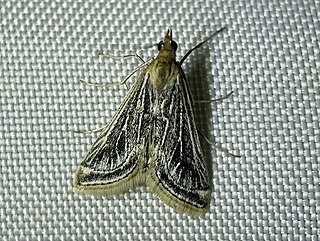
Fissicrambus is a genus of moths of the family Crambidae.
Hellinsia elliottii is a moth of the family Pterophoridae. It is found in North America, including Mississippi, New York, Iowa, Quebec, Alberta and Ontario.
Elophila nebulosalis, the nebulous munroessa moth, is a moth in the family Crambidae. It was described by Charles H. Fernald in 1887. It is found in North America, where it has been recorded from South Carolina to Florida.
Epina alleni is a moth in the family Crambidae. It was described by Charles H. Fernald in 1888. It is found in North America, where it has been recorded from Indiana, Maine, Massachusetts, Pennsylvania and South Carolina.
Crambus multilinellus, the multinellus grass-veneer, is a moth in the family Crambidae. It was described by Charles H. Fernald in 1887. It is found in North America, where it has been recorded from Florida, Georgia, Illinois, Maryland, Minnesota, Mississippi, North Carolina, Ontario and South Carolina.
Fissicrambus intermedius is a moth in the family Crambidae. It was described by William D. Kearfott in 1908. It has been recorded from the US states of Arizona, California and Texas.
Loxocrambus coloradellus is a moth in the family Crambidae. It was described by Charles H. Fernald in 1893. It is found in North America, where it has been recorded from California and Colorado.
Neodactria zeellus is a moth in the family Crambidae. It was described by Charles H. Fernald in 1885. It is found in North America, where it has been recorded from Alberta, Florida, Indiana, Maine, Maryland, Massachusetts, Mississippi, Ohio, Oklahoma, Pennsylvania and Tennessee.
Parapediasia hulstellus is a moth in the family Crambidae. It was described by Charles H. Fernald in 1885. It is found in North America, where it has been recorded from Texas.
Thaumatopsis bolterellus is a moth in the family Crambidae. It was described by Charles H. Fernald in 1887. It is found in North America, where it has been recorded from New Mexico and Texas.
Thaumatopsis magnificus is a moth in the family Crambidae. It was described by Charles H. Fernald in 1891. It is found in North America, where it has been recorded from New Mexico, Arizona and Colorado.
Thopeutis forbesellus is a moth in the family Crambidae. It was described by Charles H. Fernald in 1896. It is found in North America, where it has been recorded in California, Illinois, Indiana, Louisiana, Maine, Maryland, Massachusetts, Minnesota, New Brunswick, Ohio, Ontario, Quebec and South Carolina.
Daulia magdalena, the glittering Magdalena moth, is a moth in the family Crambidae. It was described by Charles H. Fernald in 1892. It is found in North America, where it has been recorded from Alabama and Florida.

Pyrausta inornatalis, the inornate pyrausta moth, is a moth in the family Crambidae. It was described by Charles H. Fernald in 1885. It is found in United States, where it has been recorded from Arizona, California, Florida, Arkansas, Kansas, Louisiana, Missouri, Oklahoma, Tennessee and Texas. It is also found in Mexico. It has also been recorded as being in Alabama, Illinois, Oregon, Georgia, Kentucky, Mississippi, North Carolina, South Carolina, Virginia, and West Virginia.

Pyrausta linealis is a moth in the family Crambidae. It was described by Charles H. Fernald in 1894. It is found in North America, where it has been recorded from eastern Washington to California and Nevada.
Donacaula maximellus is a moth in the family Crambidae. It was described by Charles H. Fernald in 1891. It is found in North America, where it has been recorded from Florida, Georgia, Louisiana, Mississippi, Nebraska, North Carolina and South Carolina.
Leptosteges flavicostella is a moth in the family Crambidae. It was described by Charles H. Fernald in 1887. It is found in North America, where it has been recorded from Florida, South Carolina and Georgia.
Pogonogenys proximalis is a moth in the family Crambidae. It was described by Charles H. Fernald in 1894. It is found in North America, where it has been recorded from California and Nevada.
Choristostigma plumbosignalis is a moth in the family Crambidae. It was described by Charles H. Fernald in 1888. It is found in North America, where it has been recorded from British Columbia and Alberta to Arizona and New Mexico, east to South Dakota. The habitat consists of grassland coulees, the aspen parkland, as well as wooded areas in boreal forests and mountainous areas.

Diasemiodes nigralis is a moth in the family Crambidae. It was described by Charles H. Fernald in 1892. It is found in North America, where it has been recorded from Florida to Texas, with strays north to at least Michigan and Maryland.



